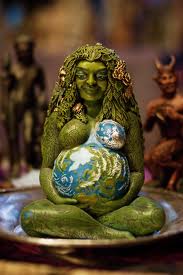Beltane
(Bell-tain) takes place May 1st.
Also known as May Day, Walpurgisnacht/Walpurgis
Night, The Fertility Festival, Bealtaine, Bhealtainn, Bealtinne, Festival of
Tana-Strega, Giamonios, Rudemass, Walburga-Teutonic, Fairy Day ,Sacred Thorn
Day, Rood Day, Beltain, Floriala-Roman feast of flowers, Fire of Bel/Bright Fire
and Fire Festival. Beltane is the second principal Celtic festival with Samhain being the first.
Observed on May 1st, festivities usually
start on the last night of April. It's a
time to welcome the abundance of the fertile earth. There are many
different ways you can celebrate Beltane, but the focus is usually on
fertility. It's the time when the earth
mother opens up to the fertility god, and their union brings about healthy
livestock, strong crops, and new life all around.
Beltane traditionally marks the arrival
of summer, although summer doesn’t technically start for another month and a
half.
Beltane,
and its counterpart Samhain, divide the year into its two primary seasons,
winter (Dark Part) and summer (Light Part). As Samhain is about honoring Death,
Beltane, its counter part, is about honoring Life. It is the time when the sun
is fully released from his bondage of winter and able to rule over summer and
life once again.
Beltane,
like Samhain, is a time of "no time" when the veils between the two
worlds are at their thinnest. No time is when the two worlds intermingle and
unite and the magic abounds! It is the time when the Faeries return from their
winter respite, carefree and full of faery mischief and faery delight.
Love
is in the air at Beltane. In our rituals, we celebrate the union between the
Great Mother and her young Horned God. Their coupling brings fresh new life on
Earth. Some form of this Great Rite is enacted on this sabbat in nearly every
modern pagan circle. The Great Rite symbolizes the sacred marriage, or sexual
union, of the the Lord and Lady. Often the rite is performed symbolically by a
male and female who place a knife (a phallic symbol) into a chalice (a female
or yonic symbol). In Old Europe, whole villages would celebrate May Day by
slipping away into the woods for indiscriminate sexual encounters.
Songs: Beltane Fires, Beltane Song, Fire Leap,
Freedom, Summerisle Song, Like A Prayer, The Worship of Trees, Green and Grey,
Witches Reel, The Mummer’s Dance, Invocation, Maypole Dance Chant, Beltane Fire
Dance Song.
Activities: Dancing Around A Maypole, Enjoying a
Bonfire, Purifying/Cleansing your Space, Do Spells for ‘Prosperity’ ‘Love’ ‘Fertility’
and ‘Protection/Safety’, Jump a Bonfire (carefully) and Make a Wish, Scatter
the Ashes of your Bonfire in the garden to ensure Fertility, Look for Fairies, Gather
the First Herbs of the Season, Picnic in the Fields, Make Love, Wash your face
with the Morning Dew and Decorate your Hair with Ribbons, Walk around your
property to check that all is in order, Feasting, Get Handfasted/Jump the
Broom, Give a Food Basket to a Food Drive, Have Breakfast foods for Dinner.
Foods: Flaxseeds, Almonds, Spring Soups, Mushrooms,
Oatmeal, Dairy Products, Candied Flowers, Oatcakes, Flower Wine, Bread, Cereal,
Strawberries, Cherries, Greens, Salads, Honey, Sweets, Eggs, Custards, Vanilla,
Ice Cream, May Bowl (Wine/Fruit/Flower Punch), Pancakes/Waffles, Sausage,
Cheese.
Crafts: Make/Decorate a Maypole, Make a Flower
Wreath, Make an offering plate of fruits and nuts to leave for the Fairies, Make
a Flower Garland, Plant Seeds in the Garden or in some Flowerpots, Weave a Basket.
Colors: Green, White, Pale Pink, Yellow, Blue,
Brown, Red, Rainbow.
Symbols: Flowers, Bonfires, Doves, Ribbons, Swans,
Chalice, Baskets, Cats, Maypole, Rabbits, Eggs, Butterchurns, Honey Bees, Faeries.
Stones: Rose Quartz, Garnet, Emerald, Amber, Tourmaline,
Sapphire, Malachite, Beryl, Bloodstone, Orange Carnelian.
Herbs: Fireweed, Dragon’s Blood, Coriander, Marjoram,
Fern, Blessed Thistle, Curry, Broom, Ash, Nettle, Flaxseed, Clover, Hawthorn, Radish,
Paprika, Snapdragon, Meadowsweet, Woodruff, Elder Leaves, Belladonna, Mint, St. John’s Wart, Rosemary.
Flowers: Dogwood, Daffodils, Rose, Foxglove, Lilly
of the Valley, Ivy, Marigold, Violets, Daisies, Bluebells, Lilac, Primrose.
Incense: Vanilla, Rose, Musk, Jasmine, Ylang
Ylang, Peach, Passionflower, Frankincense, Lilac.
Gods: Bel, Apollo, Bacchus, Bel-Belanos, Cernunnos,
Pan, Herne, Faunus, Cupid-Eros, Odin, Orion, Frey, Robin Goodfellow, Puck, and
The Great Horned God, Artemis.
Goddesses: Arianrhod, Astarte, Ariel, Var, Skadi,
Shiela-na-gig, Cybele, Xochiquetzal, Freya, Rhiannon, Aphrodite, Bast, Diana,
Flora, Maia, Venus.














